Course 8 - Models of product differentiation
1/10
There's no tags or description
Looks like no tags are added yet.
Name | Mastery | Learn | Test | Matching | Spaced |
|---|
No study sessions yet.
11 Terms
Introduction - Products
Most products ≠ perfectly substitutable → Reasons:
Physical characteristics of products ≠ idem
Products = branded differently / designed for specific consumer groups
Economists distinguish vertical & horizontal product differentiation
HORIZONTALLY product differentiation - Definition
When each product = preferred by at least 1 consumer group
OR
When for same P consumers disagree on product they prefer
Ex.: Marketeers in fast moving consumer goods design product offers for groups of consumers according to their age, social-economic groups, passions, …
HORIZONTALLY product differentiation - Firm perspective
In horizontally differentiated product markets, fims choose:
price of the product &
its position in the product space
Usually assumed that consumers = located on a line (Hotelling) / circle (Salop) & incur cost when purchasing product far from them
→ Geographical interpretation:
Consumers incur higher cost to move a more distant shop
→ Products ≠ perfectly substitutable, consumers incur psychological transportation cost when consuming product that ≠ ideal
Proof:
1) Show that in Bertrand model where firms = located in different positions on the line, both firms set P above MC & enjoy positive profits
2) If firms choose locations, but not choose P, they choose to be located in same place
3) Firms choose P & location with linear & quadratic transportation costs
Proof - (1) P choice in differentiated product market (Bertrand model)
Bertrand model where 2 firms produce differentiated products:
2 producers denoted 1 & 2 with MC c = located at extreme locations of the [0,1] interval on which consumers = uniformly distributed
Firms max πi = (pi - c)Qi(pi,pj)
Indirect U fct of consumer located in x with preferred product U r & consuming 1 unit of product i located in li = r - T |li - x| - pi
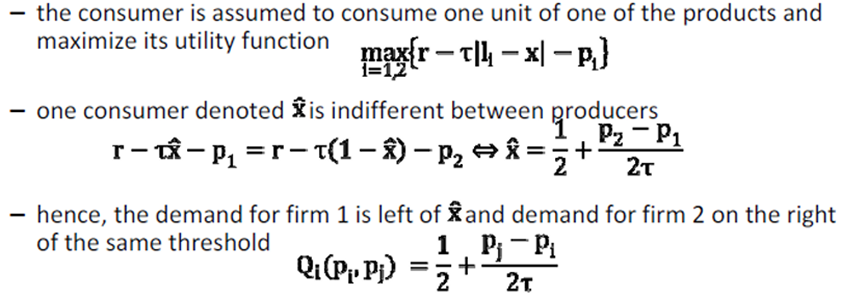

Due to product differentiation, equilibrium P > MC:
→ Each firm faces D fct that ≠ perfectly elastic
→ Producers of more differentiated products (higher τ) enjoy higher price-cost margins
Proof - (2) Location choice in differentiated product market
Assume 2 firms ≠ choose P BUT choose location:
Model describes industries in which P = regulated (p*), but firms choose non-P aspects of their product offer
Mass 1 of consumers = assumed to have tastes uniformly distributed on interval [0,1]Indirect U fct of consumer located in x, consuming 1 unit of product i locatedli = vi(x) = r - T |li - x| - p*


In unique NE of location game, both firms locate at center of support
No firm has an incentive to deviate from this equilibrium, bc it would serve smaller proportion of market
If firm 1 moves to the right, firm 2 has an incentive to also move to the right & serve larger proportion of market
This simple model shows that firms that have opportunity to differentiate their products, choose not to do so:
From social perspective, total transport costs = minimized at locations ¼ & ¾
Intro of competition ≠ improve welfare: If fixed production costs, customers better off with single firm
Proof - (3) P & location choice in differentiated product market (Part 1)
Firms simultaneously choose P & location
Reservation value r for their ideal product, a mass 1 of consumers have tastes uniformly distributed on interval [0,1] & have U fct vi(x) = r - T |li - x| - p*
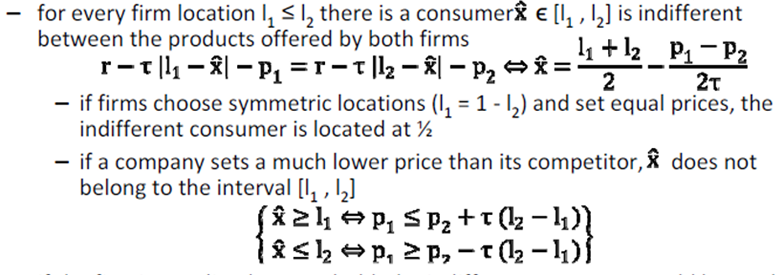
If first inequality ≠ hold, indifferent customer would be on left of l1 or in other terms, also consumers on left of l1 prefer good 2 to good 1
There = non-linearity at P1 = p2 + T(l2 - l1)
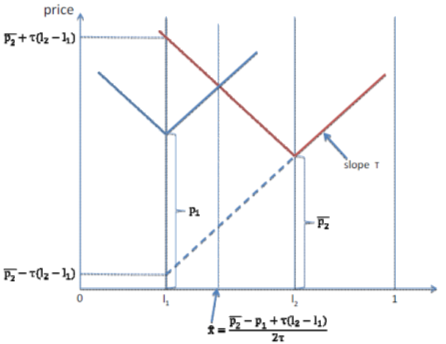
Proof - (3) P & location choice in differentiated product market (Part 2)
Profits = price-cost difference times demand:

Profit fct shows downward jump when firm starts sharing market with producer of good 2
Similarly, profit fct drops to 0, when no customer buys a good 1
Profit fct ≠ quasi-concave & has 2 local suprema
First order approach can lead to errors
Locations ≠ necessarily at the extremes:
Assuming that prices = such that the indifferent buyer belongs to
For l1 = l2 unique P equilib = p1 = p2 = c
Other P equilibria exist, but it can be demonstrated that, in dynamic setting, firms have a tendency to move closer to one another (offer closer substitutes) to increase D, which leads to instability in competition
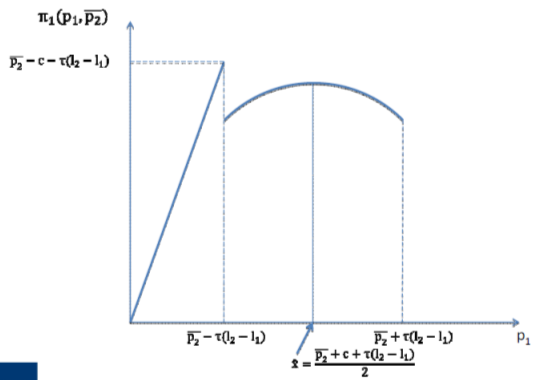
Proof - (3) P & location choice in differentiated product market (Part 3)
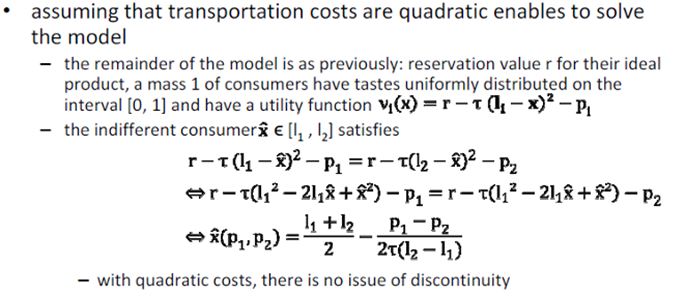
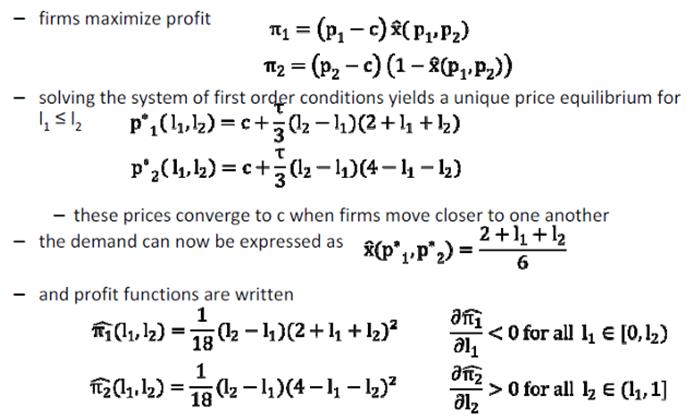
The subgame perfect equilibrium (SPE) of the 2-stage game with quadratic transportation costs, firm choose l*1 = 0 & l*2 = 1
With quadratic transportation costs, firms seek differentiate their product offerings in order to build some monopoly power vis-à-vis consumers located in their vicinities
In general, there are always 2 forces at play:
Competition effects drives firms apart in order to increase product differentiations & raise market power
Market size effect brings firms closer & reduces product differentiation
VERTICALLY product differentiation - Definition
When consumer groups agree on relative value of products, bc different q of desirable characteristic = embedded in product
Ex.: CPU (GHz), RAM (Mo), size screen of weight for laptops, l/100km or CO2g/km for cars, ABS, air conditioning, horsepower
VERTICALLY product differentiation - Firm perspective (Part 1)
Products = vertically differentiated, when consumer groups agree on the relative value of products
→ products = different qualities
Quality = described by a number : si ∈ [▁s,s ̅ ] ⊂ R+
Consumers agree: high quality = better than low, but differ in intensity of their preferences → θ ∈ [▁θ,θ ̅ ] ⊂ R+
θ = uniformly distributed on its support & consumers = of mass M = θ ̅ - ▁θ
Consumer’s U fct:
u1 = q0 + θ(s1 - s ̅ )
with outside option u0 = q0 - r - θs ̅ &
budget constraint y = r + θs ̅
Consumers choose whether to buy product maximizing:
v(p, y ; θ)=max[0, max((r - p1 + θs1)]
2 firms = assumed to have 0 MC (independent of quality) but firm 2 produces higher quality good s1 < s2 & set P below r(p1, p2 < r)
VERTICALLY product differentiation - Firm perspective (Part 2)
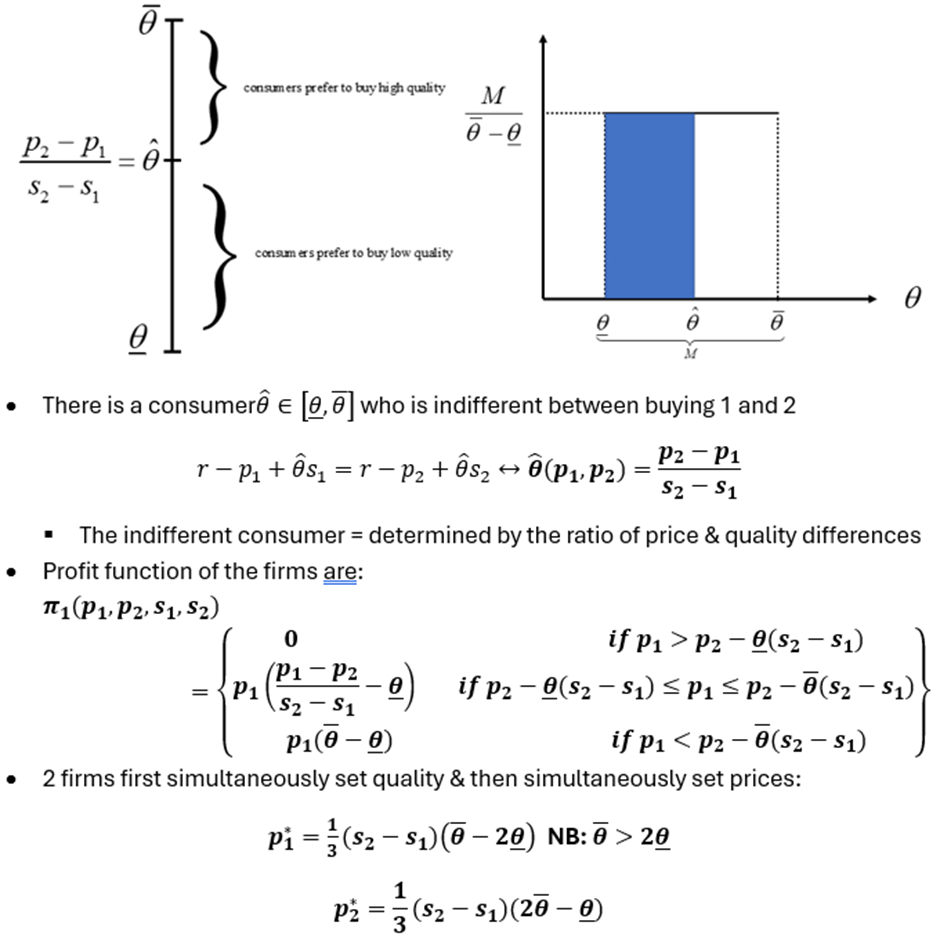
Equilibrium P only depend on quality differences:
→ Not only P of high quality firm increase with quality difference
BUT P of low quality firm also increases with quality difference (which = more surprising & due to assumption that all consumers buy in market)
